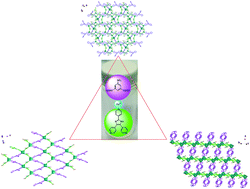Three new Zn-based metal–organic frameworks exhibiting selective fluorescence sensing and photocatalytic activity†
Abstract
Three different metal–organic frameworks, [Zn5(L)4(H2tpim)2(FA)4(H2O)2]n (1), [Zn(L)(Htpim)]n (2) and [Zn(L)(Htpim)]n (3) (HFA = formic acid), have been synthesized in a one-pot solvothermal reaction of Zn(NO3)2·6H2O, 5-nitroisophthalic acid (H2L), and 2,4,5-tri(4-pyridyl)-imidazole (Htpim). Single-crystal X-ray diffraction analyses reveal that compound 1 is a double layer 2D {4·6·72·8·9}{4·6·8}3{6·7·9}2{72·10} topology network because of the existence of FA. In contrast, 2 displays an irregular 2D (44) topology, while 3 exhibits a 2D parallelogrammic (44) topology net built by symmetrical L and Htpim ligands in an up and down mode with binuclear [Zn2(COO)2] units. As far as the ratios of Zn/L/Htpim are concerned, 2 and 3 can be considered as isomers. The thermal stabilities, luminescence properties, selective fluorescence sensing and photocatalytic activities of 1–3 were also investigated. They all display high sensitivity as fluorescent sensors in the detection of acetone (ACE). Moreover, 1–3 exhibit relatively good photocatalytic activity towards the degradation of rhodamine B in aqueous solution under UV irradiation.



 Please wait while we load your content...
Please wait while we load your content...